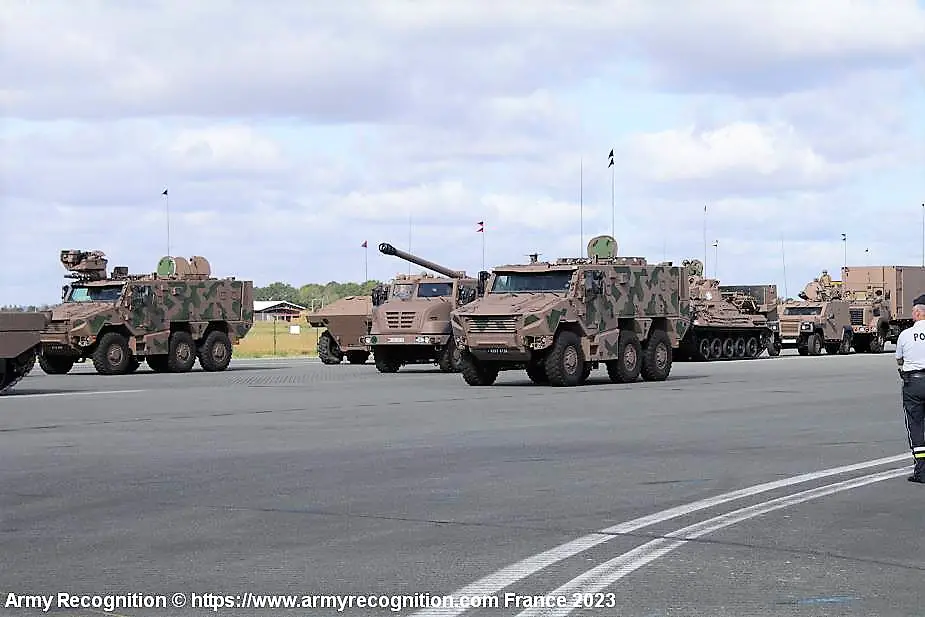Breaking news
French Defense to benefit from increased budget by 413 billion Euros.
On July 13th, France's Parliament gave approval to President Emmanuel Macron's plan to increase military spending by 413.3 billion Euros spread over a 7-year period of time. This significant boost in funding, which forms part of France's 2024-2026 budget, was initially announced by the President in January. The decision to increase military expenditure by over one-third can arguably be attributed to the ongoing conflict in Ukraine.
Follow Army Recognition on Google News at this link

The French ground force will continue its modernization efforts, with a focus on the SCORPION program for ground vehicles (Picture source: Army Recognition)
As detailed by Henry Stewart in OVD, the French Ministry of Defense has released specific investment details for various sectors:
• Intelligence and counterintelligence: 5 billion Euros will be allocated for enhancing intelligence and counterintelligence capabilities.
• Overseas capabilities and initiatives: 13 billion Euros will be invested in bolstering overseas capabilities and initiatives.
• Drones: 5 billion Euros will be dedicated to drones, which include unmanned systems and remotely operated munitions (loitering munitions). Additionally, Airbus is currently developing the Eurodrone medium-altitude, long-endurance UAV (Unmanned Aerial Vehicle) for France, Spain, and Germany.
• Surface-to-air defense capabilities: 5 billion Euros will be utilized for strengthening surface-to-air defense capabilities.
• Munitions: 16 billion Euros will be allocated for munitions, including the modernization of long-range anti-ship missiles, F321 heavy torpedoes, and the development of new surface-to-air and air-to-air interceptors such as MBDA's Aster-MICA and Meteor families.
• Maintenance in Operational Condition (MCO): 49 billion Euros will be dedicated to the maintenance in operational condition of all French armed forces.
• Innovative technology investments: 10 billion Euros will be invested in innovative technologies, including directed energy technology, swarming drones, and robotic capabilities.
• Space domain: 6 billion Euros will be allocated for the development of space-related capabilities.
• Cyber defense: 4 billion Euros will be invested in strengthening cyber defense measures.
These investments will cover all branches of the French armed forces as well as France's intelligence community. Specific areas of focus include the advancement of drone technology, the modernization of long-range anti-ship missiles, and the enhancement of surface-to-air defense capabilities.
For the French Navy, additional funding will be provided for the PANG aircraft carrier project, as well as the planned acquisition of 15 FDI frigates by 2030.
The French ground force will continue its modernization efforts, with a focus on the SCORPION program for ground vehicles. Furthermore, joint discussions and spending between France and Germany will revolve around the development of a joint main battle tank, a “delicate” topic often discussed in the larger framework of the MGCS.
Regarding the Air Force, the procurement of Dassault Rafale fighter jets remains a priority, with an expectation of acquiring 32 new aircraft from Dassault Aviation between 2030 and 2032. Additionally, France, Spain, and Germany are collaborating on the Future Combat Air System (FCAS) program, aiming to demonstrate their next-generation fighter aircraft by 2027, benefiting from French investment. Let us just mention that Belgium recently got the status of “observer” in this program.
President Macron ensures that the support provided to Ukraine will not impede France's own capability development. The majority of the French support to Ukraine will be channeled through the European Union's European Peace Facility, an off-budget funding mechanism specifically designed for military and defense actions conducted by the European Union.
The Air Force will also see the deployment of the ASMP-R medium air-to-surface missile, a nuclear-capable system employed on French fighter jets. Additionally, resources will be allocated towards the development of the ASN4G, a nuclear-capable air-to-ground hypersonic cruise missile, which will be created and manufactured by the French company ArianeGroup.
France's ambitions extend to the realm of space, where they plan to expand their capabilities. They will launch a new orbital space surveillance project utilizing nanosatellites to identify potential threats to national security. Concurrently, France is developing an on-orbit laser system known as FLAMEHE and a ground-to-space laser system called BLOOMLASE. The aim is to make both projects operational by the end of the decade.
Defense News July 2023


























